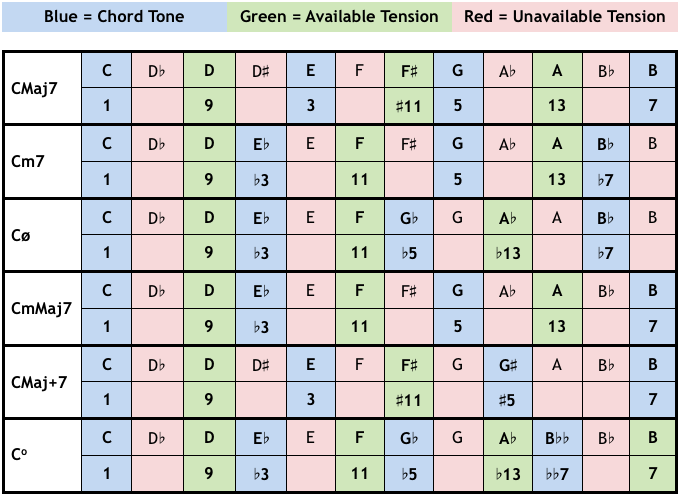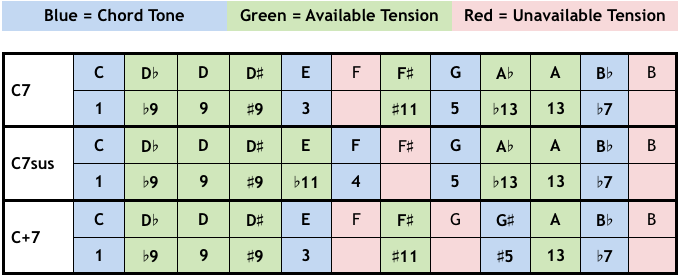Dissonant Intervals
There are two types of intervals: Consonant Intervals and Dissonant Intervals
| Consonant Intervals | Dissonant Intervals |
|---|---|
| Perfect Unison | Semitone (Minor 2nd) |
| Perfect Octave | Major 7th |
| Perfect 5th | Tritone |
| Perfect 4th | Minor 9th (Flat 9th) (octave + semitone) |
Dissonant intervals create ‘tension’ which sound like they want to resolve to consonant intervals. This is the reason the Dominant chord feels like it wants to resolve to the Tonic chord. The Dominant chord is an inherently dissonant chord because it has a tritone interval between its 3rd and 7th, and as such it wants to resolve towards the consonant Tonic chord.
In Jazz, the flat 9th interval is generally avoided because it is considered very dissonant. This flat 9th interval also determines whether a note is an Avoid Note (AKA Unavailable Tension) or conversely, an Available Tension.
Available Tensions
In theory, all chord tensions (extensions and alterations) exist on all chord types; however, in practice only some are used over each chord type/quality. These are called Available Tensions.
As we learned in the previous lesson, the root, 3rd, 5th and 7th of a chord are called Chord Tones, and the 9th, 11th and 13ths of a chord are called Tensions. As such, each of the 12 notes in an octave can be divided into the following categories and subcategories:
- Chord Tones = 1, 3, 5, 7
- Weak Chord Tones = 1 & 5
- Guide Tones = 3, 7
- Tensions = every other note (9, 11, 13, or alterations of these –♭9, #9, etc.)
- Available Tensions = some tensions based on chord type
- Avoid Notes (AKA Unavailable Tensions) = the remainder of tensions
Guide Tones are the most harmonically important notes because they establish the quality of the chord.
Avoid Notes are notes that cause a dissonant interval with one of the chord tones.
(Guide Tones and Avoid Notes will be discussed in more detail in future lessons).
So there are two types of tensions: available and unavailable. These vary based on chord type.
- Available tensions – are tensions that complement the consonance/sound/feel of the chord;
- Unavailable tensions – are tensions that conflict with the consonance/sound/feel of the chord. More specifically, an unavailable tension is a note that creates a ♭9 interval with a chord tone.
So again, while in theory all tensions exist on all chord types, in practice only ‘available tensions’ are used. For example, a CMaj7♭9 chord exists in theory, but you will never find it in practice because a ♭9 is not an available tension over a Maj7 chord. The Maj7 has available tensions of 9, #11, 13.
Non-Dominant Chords
First let’s deal with all chords except for Dominant chords. Below is a table which lists a number of different non-dominant chord types and their respective available tensions (coloured Green).

Notice that:
- Chord tones make up the chord, these are coloured blue.
- The chord tones plus one semitone are called ‘avoid notes’, these are coloured red.
- The chord tones plus two semitones are called ‘available tensions’, these are coloured green.
- All the other notes are also classified as ‘avoid notes’, and coloured red.
Using the above rules you can discover the ‘available tensions’ of any non-dominant chord.
Dominant Chords
Dominant chords are a bit different. They are already considered quite dissonant because of that tritone interval between the 3rd and 7th. With dominant chords, you are allowed to create a ♭9 interval against the root and 5th; but NOT against the 3rd and 7th. This is because the 3rd and 7th are Guide Tones and are thus more harmonically important. So you don’t want to clash with the more important notes (3rd & 7th), but you can clash with the less important notes in a Dominant chord (root and 5th).
Below is a table which lists a number of different dominant chord types and their respective available tensions (coloured Green).

Notice that:
- Chord tones make up the chord, these are coloured blue.
- The guide tones (3rd & 7th) plus one semitone are called ‘avoid notes’, these are coloured red.
- All the other notes are ‘available tensions’, these are coloured green.
(Both ‘unavailable tension’ and ‘avoid note’ relate to notes that create a dissonant interval with one of the chord tones (which is why I use them synonymously), but ‘unavailable tensions’ are in the context of chords while ‘avoid notes’ are in the context of scales).
What makes Available Tensions ‘available’?
So there are four basic 7th chords:
- Maj7
- V7
- m7
- mMaj7
(There are also dim7 and Aug7 chords but these work a little bit differently).
And each 7th chord has a particular feel or sound.
| Chord | Feel/Sound |
|---|---|
| CMaj7 | Happy or calm |
| C7 | Tense |
| Cm7 | Sad |
| CmMaj7 | Confused sadness |
It is believed that an available tension complements the sound or feel or consonance of the 7th chord. For example:
- A CMaj7 chord sounds ‘happy’ and ‘calm’
- A CMaj9 chord (available tension) still retains the same sound or feel as the CMaj7 chord. It still feels ‘happy’ and ‘calm’.
- Similarly, a CMaj13#11 (all available tensions) also retains the ‘happy’ and ‘calm’ sound of a standard CMaj7 chord.
- But a CMaj7♭9 chord (unavailable tension) no longer sounds ‘happy’ or ‘calm’. Instead, it sounds very dissonant and jarring. The ♭9 ruins or clashes with the feel of a CMaj7 chord – and is therefore ‘unavailable’. a CMaj7♭9 chord no longer feels or sounds like a CMaj7 chord. It sounds more like a diminished chord of some kind.
- Similarly, a Cm7 chord sounds ‘sad’.
- A Cm11 (available tensions) also sounds ‘sad’.
- But a Cm7♭9#11 (unavailable tensions) sound harsh and tense. The ♭9 and #11 ruin the feel of the minor chord.
- On the other hand, a C7 chord already sounds ‘tense’ and ‘dissonant’ (again, because of the tritone between the 3rd and 7th).
- So a C7♭9#11♭13 (all available tensions) still sounds ‘tense’ and ‘dissonant’, so still feels like a C7 chord, so is a perfectly fine chord to play.
- However, a C11 (unavailable tension) is thought to ruin the purity of the C7 chord because the 11th (F) clashes with the 3rd (E). (This makes it sound like a C7sus chord).
- Similarly, the C7 cannot have a ♮7 (B) because it already has a ♭7 (B♭). As such, this is also an unavailable tension.
In Practice
So if you’re playing a song and you want to extend or alter a particular chord to create a more complex harmony, make sure you use ‘available tensions’ – so that the chord tensions do not clash with the underlying consonance and harmony of the chord.
And just a quick supplementary video with an example: